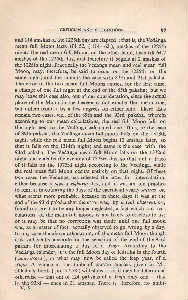Page 713 - Lokmanya Tilak Samagra (khand 2)
P. 713
CRITICISM AND SUGGESTIONS 65
and 114 amshas of the 1225th day are elapsed ; that is, the Vedanga
mean full Moon lasts till 52, ( 114-62 ), amshas of the 1225th
night. The real mean full Moon, on the other hand, lasts till 64-2
amshas of the 1226th day, and therefore it begins at 2 amshas of
the 1225th night. Practically the Vedanga mean and real mean full
Moon, may, therefore, be said to occur on the 1225th or the
same night; and the same is the case with 87th and 91st paksha.
The error in the two mean full Moons causes, for the first time,
a change of one full night at the end 6f the 85th paksha; but we
may leave this case also, out of our consideration, since the actual
place of the Moon in t~e heaven is not exactly the mean one,
but differs from it by a few degrees on either side. There thus
remain two cases, viz., of the 89th and the 93rd paksha, wherein
according to our mean calculations, the real full Moon falls on
the night next to the Vedanga calculated one. Thus, in the case
of 89th paksha, the Vedanga mean full moon falls on the 1313th
night, while the real mean full Moon begins 13 amshas later, so
that it falls on the 1314th night; and same is the case with the
93rd paksha. The Vedanga mean full Moon falls on the 1372nd
night and ends by the evening of 1373rd day, so that not a trace
of it falls on the 1373rd night according to the Vedanga, while
the real mean full Moon occurs entirely on that night. Of these
two cases the Vedanga has selected the latter for intercalation,
either because it was a vi.rhuvat day, and it was an old practice
to omit it in counting the days of the sacrificial yearly sattras or,
what seems more probable, because in these days it was at the
end of the 93rd paksha that the error was, by actual observations,
found too great to be any longer neglected, a fact which our cal-
culations of the mean full moons is not likely to disclose to us;
or it may be that no correction was made until one full moon
was, as a matter of fact, actually ob§erved to go wrong by a day.
In any case the above calculation, of the mean full Moon though
it is, sufficiently accurate for the selection of the end of the 93rd
paksha for intercalating a day in a Yuga. According to the
Vedanga calender, it is the full Moon day of Kartika in the fourth
( anuvatsara ), or what may now be called the leap year, of a
Yuga. A glance at the table of parvan amshas given in Mr.
Dikshit's book ( pp. 77-78 ) will show- or it may be determined
otherwise- that out of 124 pakshas of a Yuga only one- that
is, the 93rd - ends in 31 amshas. There is therefore, no ambi-
V. 5

